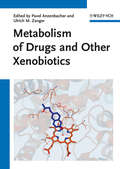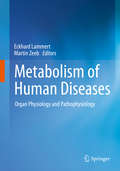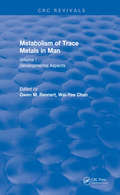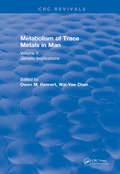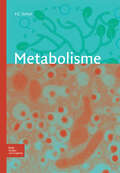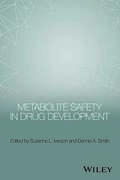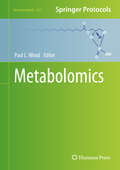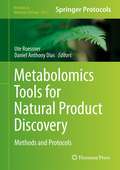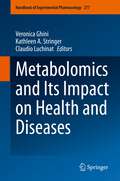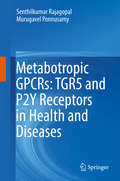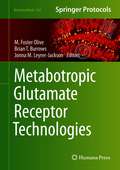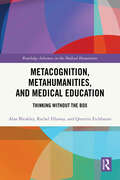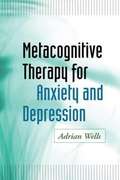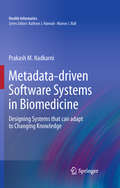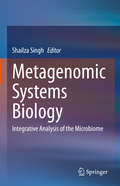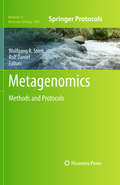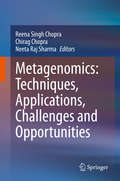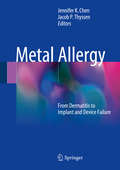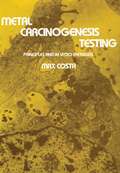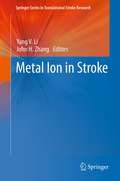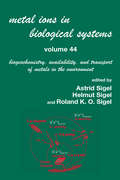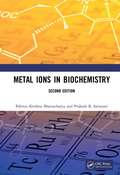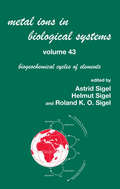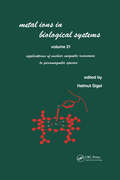- Table View
- List View
Metabolism of Drugs and Other Xenobiotics
by Pavel Anzenbacher Ulrich M. ZangerA practice-oriented desktop reference for medical professionals, toxicologists and pharmaceutical researchers, this handbook providessystematic coverage of the metabolic pathways of all major classes of xenobiotics in the human body. The first part comprehensively reviewsthe main enzyme systems involved in biotransformation and how they are orchestrated in the body, while parts two to four cover the threemain classes of xenobiotics: drugs, natural products, environmental pollutants. The part on drugs includes more than 300 substances fromfive major therapeutic groups (central nervous system, cardiovascular system, cancer, infection, and pain) as well as most drugs of abuseincluding nicotine, alcohol and "designer" drugs. Selected, well-documented case studies from the most important xenobiotics classes illustrate general principles of metabolism, making this equally useful for teaching courses on pharmacology, drug metabolism or moleculartoxicology.Of particular interest, and unique to this volume is the inclusion of a wide range of additional xenobiotic compounds, including food supplements, herbal preparations, and agrochemicals.
Metabolism of Human Diseases
by Eckhard Lammert Martin Zeeb"Metabolism of Human Diseases" examines the physiology of key organs (e. g. brain, eye, lung, heart, blood vessels, blood, immune system, gastrointestinal tract, pancreas, liver, fat tissue, kidney, reproductive system, teeth, bone and joints) and how defective metabolism and signaling pathways within these organs contribute to common human diseases. The latter include depression, schizophrenia, epilepsy, Parkinson's disease, Alzheimer's disease, migraine, multiple sclerosis, Down syndrome, macular degeneration, glaucoma, asthma, COPD, pneumonia, atherosclerotic heart disease, heart failure, stroke, varicose veins, Sickle cell disease, hyperlipidemia, fever, sepsis, allergies, peptic ulcer, gastroenteritis, lactose intolerance, colon cancer, diabetes, cirrhosis, metabolic syndrome, hypertension, chronic kidney disease, gout, urinary tract infections, kidney stones, dental caries, osteoporosis, osteoarthritis, rheumatoid arthritis, breast cancer and prostate cancer. The book also describes commonly used drugs and explains their molecular targets. It provides the first comprehensive and detailed summary of the metabolism of individual organs and their physiological and pathological functioning. Thus it serves as a useful supplement to previous textbooks of human physiology "Metabolism of Human Diseases" is a must-have, state-of-the-art textbook written by International experts for graduate students, postdocs and scientists in metabolic research, biochemistry, physiology and pharmacy as well as for physicians interested in molecular mechanisms underlying common human diseases.
Metabolism of Trace Metals in Man Vol. I: Developmental Aspects (CRC Press Revivals)
by Wai-Yee Chan Owen M. RennertA vast literature exists dealing with trace metals and a number of outstanding monographs deal with the biological, biochemical, or clinical effects of a specific trace metal or trace metals in general. However, newer aspects of trace metal research, i.e. the developmental aspects and generic implications, have not been systematically discussed in any existing texts. The present two volumes will summarize the present status of research in these areas and serve as milestones for future development in these areas of trace metal research.
Metabolism of Trace Metals in Man Vol. II: Genetic Implications (CRC Press Revivals)
by Owen M. Rennert and Wai-Yee ChanA vast literature exists dealing with trace metals and a number of outstanding monographs deal with the biological, biochemical, or clinical effects of a specific trace metal or trace metals in general. However, newer aspects of trace metal research, i.e. the developmental aspects and generic implications, have not been systematically discussed in any existing texts. The present two volumes will summarize the present status of research in these areas and serve as milestones for future development in these areas of trace metal research.
Metabolisme
by Frans C. SchuitHet metabolisme ofwel de stofwisseling van de mens is een complex chemisch proces dat van invloed is op veel facetten van gezondheid en ziekte. Het vormt dan ook een onmisbaar onderwerp in opleidingen als geneeskunde, biomedische wetenschappen, farmacie en mondzorg. Studenten en docenten hebben lange tijd moeten putten uit een geringe keus aan duidelijk medische georiënteerde leerboeken over het menselijke metabolisme. Dit boek vormt een welkome aanvulling op dit titelaanbod. Metabolisme bestaat uit twaalf hoofdstukken, verdeeld over twee lagen. De eerste laag biedt de student de kernleerstof en wordt ondersteund door 260 afbeeldingen, concrete leerdoelen en studeeraanwijzingen. De tweede laag gaat nader in op bepaalde onderwerpen en tast hierbij de grenzen van wetenschappelijk verantwoorde vakkennis over het menselijk metabolisme af, bespreekt de rol van pioniers in vroeger onderzoek, benoemt het belang hiervan voor huidige medische toepassingen en beschouwt het onderwerp voorts vanuit de evolutieleer. Deze verdieping in de stof is herkenbaar gemaakt in vier thema’s en met ruim 600 verwijzingen naar recente wetenschappelijke literatuur.De veelzijdige samenstelling van deze tweede informatielaag biedt studenten de mogelijkheid een leerpad te volgen dat bij de eigen interesses aansluit. Door deze opzet fungeert het boek als een handige leidraad voor studenten aan alle bovengenoemde opleidingen. Zo dient Metabolisme als gids tijdens een reis op weg naar onafhankelijk en kritisch nadenken over een complex proces.
Metabolite Safety in Drug Development
by Dennis A. Smith Suzanne L. IversonA reference on drug metabolism and metabolite safety in the development phase, this book reviews the analytical techniques and experimental designs critical for metabolite studies. It features case studies of lessons learned and real world examples, along with regulatory perspectives from the US FDA and EMA.* Reviews the analytical techniques and experimental designs critical for metabolite studies* Covers methods including chirality, species differences, mass spectrometry, radiolabels, and in vitro / in vivo correlation* Discusses target pharmacology, in vitro systems aligned to toxicity tests, and drug-drug interactions* Includes perspectives from authors with firsthand involvement in industry and the study of drug metabolites, including viewpoints that have influenced regulatory guidelines
Metabolomics (Neuromethods #159)
by Paul L. WoodThis volume discusses the latest analytical approaches used to sample defined molecular populations of metabolites via functional group derivatization, specialized chromatographic methods, and ionization techniques. Chapters cover key methods for sample introductions to the ion source, including direct flow, gas chromatography, liquid chromatography, and capillary electrophoresis. Chapters also explore non-targeted and targeted analyses, as well as the emerging field of metallomics. In the Neuromethods series style, chapters include the kind of detail and key advice from the specialists needed to get successful results in your laboratory. Cutting-edge and authoritative, Metabolomics is a valuable resource for students, researchers, practicing physicians and veterinarians, and administrators involved in the funding of research.
Metabolomics Tools for Natural Product Discovery: Methods and Protocols
by Daniel Anthony Dias Ute RoessnerClassical natural product chemistry is transitioning to modern day metabolomics as a result of the advent of comprehensive analytical platforms and sensitive analytical instrumentation. Therefore, it is worthwhile to summarize recent developments with current analytical platforms and highlight how metabolomics is being integrated into this classical field to dereplicate and profile natural product extracts. Metabolomics Tools for Natural Product Discoveries: Methods and Protocols aims to unite diverse and recently developed methodologies and protocols in order to identify bioactive secondary metabolites for the purpose of drug discovery. Some topics covered in this volume include applications for the extraction of selected natural products from less common sources such as bryophytes and hard corals, various biological assays, comprehensive applications and strategies for GC-MS, LC-MS, and NMR, as well as protocols and strategies for the structure elucidation of isolated natural products. Written in the successful Methods in Molecular Biology series format, chapters include introductions to their respective topics, lists of the necessary materials and reagents, step-by-step, readily reproducible protocols, and notes on troubleshooting and avoiding known pitfalls. Authoritative and easily accessible Metabolomics Tools for Natural Product Discoveries: Methods and Protocols seeks to serve both professionals and research students with its well-honed methodologies for natural product isolation, biomarker discovery, dereplication, biological assays, and comprehensive metabolomic platforms available for high-throughput analyses.
Metabolomics and Its Impact on Health and Diseases (Handbook of Experimental Pharmacology #277)
by Veronica Ghini Kathleen A. Stringer Claudio LuchinatThis volume of the Handbook of Experimental Pharmacology, which celebrated its 100th anniversary in 2019, addresses the rapidly growing and evolving field of metabolomics. It has been compiled and designed to broaden and enrich your understanding as well as simplify a complicated picture of the diverse field of metabolomics. This is accomplished by chapters from experts in the field on basic principles as well as reviews and updates of analytical techniques. The variety and different perspectives of the NMR approaches are described in the chapters By David Wishart, Daniel Raftery and Ryan McKay, while mass spectrometry advances are covered by Charles R. Evans and Stefan Kempa. This book also reflects the state of the art in the application of metabolomics to cell biology (Marta Cascante and Ulrich Guenther) and chapters that share insights into the application of metabolomics in various diseases (Paola Turano and Claudio Luchinat, Rachel S. Kelly and Jessica Lasky-Su, Paige Lacy, and Angela Rogers. Relationships of metabolomics with drugs are highlighted by Robert Verpoorte (natural products drug discovery), by Oscar Millet and by Turano and Luchinat (perspectives in precision medicine) and by Daniel L. Hertz (drug-induced peripheral neuropathy). From the above list of diverse topics, we believe this book has interdisciplinary appeal and scholars with an interest in the role of metabolomics in achieving precision medicine will find it of particular or special interest.
Metabolomics: Recent Advances and Future Applications
by Vijay Soni Travis E. HartmanThis book Introduces the extensive applications of metabolomics from all possible areas of research and development so that not only an undergraduate can understand the advancement of metabolomics, but an entrepreneur can harness the knowledge to address possible problems to make a perfect tool to address their research question. Topics covered include the role of metabolomics in the development of agriculture, plant pathology, and their applications; the generalized application of the metabolomics and use of related technologies in various sectors of industries; and the future of metabolomics and upcoming related technologies that can fill the gap between different -omics and their applications for the betterment of humankind. This is an ideal book for university professors, researchers, and advanced-level scientists who are exploring different avenues in metabolomics. Availability of this concise information in one place will aid scientists by expanding their arsenal of techniques and can be helpful to bring more collaborations and to identify the expert at the global level.
Metabotropic GPCRs: TGR5 and P2Y Receptors in Health and Diseases
by Senthilkumar Rajagopal Murugavel PonnusamyThis book will provide current understandings about two ubiquitously expressed metabotropic GPCRs, G-coupled purinoreceptor type 2 (P2Y) and Takeda G-protein-coupled bile acid receptor 5 (TGR5). G protein coupled receptors (GPCRs) are the largest family of proteins implicated in majority of cellular responses. The two receptor sub-families play a central role in many physiological functions as well as in many pathological conditions. This book offers up-to-date information on the physiological functions, signaling pathways and regulatory mechanisms of P2Y and TGR5 receptors. In addition, this book provides a comprehensive overview about the abnormalities of P2Y/TGR5 receptors and their contribution in the development and progression of pathological conditions. It also covers the currently available natural, chemical and pharmacological agents targeting these two receptor families and their therapeutic implications in P2Y and TGR5 associated disorders. This book is a valuable source for beginners and researchers to follow the rapidly progressing field of these two GPCR subfamily members.
Metabotropic Glutamate Receptor Technologies (Neuromethods #164)
by M. Foster Olive Brian T. Burrows Jonna M. Leyrer-JacksonThis volume highlights various techniques used to study multiple aspects of mGlu receptor function. Chapters in this book cover topics such as modern approaches for the development and screening of allosteric modulators; fluctuations in intracellular calcium induced by mGlu receptor activation; dopamine-glutamate interactions in the central nervous system; methods for assessing mGlu receptor localization; and common techniques for evaluating mGlu modulation in behavior in rodents, including stress and alcohol drinking. In the Neuromethods series style, chapters include the kind of detail and key advice from the specialists needed to get successful results in your laboratory.Cutting-edge and practical, Metabotropic Glutamate Receptor Technologies provides researchers with a starting point to address important questions regarding mGlu and its importance. Researchers working in the fields of neuroscience and physiology of multiple peripheral systems will find this volume most useful.
Metacognition, Metahumanities, and Medical Education: Thinking Without the Box (ISSN)
by Alan Bleakley Quentin Eichbaum Rachel EllawayThis persuasive volume develops a novel approach to medical education and the medical humanities, making a case for the integration of the two to explore the ways in which ‘warm’ humanism and ‘cold’ technologies can come together to design humane posthumanist futures in medicine.There are many problems with conventional medical education. It can be overly technocratic, dehumanizing, and empathy-eroding, introducing artefacts that lead to harm and reproduce inequality and injustice. Use of the arts, humanities, and qualitative social sciences have been pursued as an antidote or balance to these problems. Arguing against the purely instrumentalist use of medical humanities in this way, this book addresses the importance of a genuine and open-ended engagement with humanities approaches in medicine. It discusses the impact of artificial intelligence and emerging theoretical frameworks and posthumanist perspectives, such as object-oriented ontology, on meaning making in medicine. It demonstrates how the key to such a transition is the recovery of the intrinsic art and humanity of metaphor-heavy biomedical science, in turn framed by models of dynamic complexity rather than static linearity.This book is an important contribution to debates around the medical humanities and its role in medical education. It is an essential read for scholars with an interest in these areas, as well as those working in science and technology studies and the sociology of health and illness.
Metacognitive Therapy for Anxiety and Depression
by Steven Hollon Adrian WellsThis groundbreaking book explains the "whats" and "how-tos" of metacognitive therapy (MCT), an innovative form of cognitive-behavioral therapy with a growing empirical evidence base. MCT developer Adrian Wells shows that much psychological distress results from how a person responds to negative thoughts and beliefs-for example, by ruminating or worrying-rather than the content of those thoughts. He presents practical techniques and specific protocols for addressing metacognitive processes to effectively treat generalized anxiety disorder, obsessive-compulsive disorder, posttraumatic stress disorder, and major depression. Special features include reproducible treatment plans and assessment and case formulation tools, plus a wealth of illustrative case material.
Metadata-driven Software Systems in Biomedicine
by Prakash M. NadkarniWhile the use of database technology is ubiquitous throughout IT (and health IT in particular), it is not generally appreciated that, as a database increases in scope, certain designs are far superior to others. In biomedical domains, new knowledge is being generated continually, and the databases that must support areas such as clinical care and research must also be able to evolve while requiring minimal or no logical / physical redesign. Appropriately designed metadata, and software designed to utilize it effectively, can provide significant insulation against change. Many of the larger EMR or clinical research database vendors have realized this, but their designs are proprietary and not described in the literature. Consequently, numerous misconceptions abound among individuals who have not had to work with large-scale biomedical systems, and graduates of a health or bioinformatics program may find that they need to unlearn what they were taught in database and software design classes in order to work productively with such systems. A working knowledge of such systems is also important for individuals who are not primarily software developers, such as health informaticians, medical information officers and data analysts. This book is, in a sense, intended to prepare all of the above individuals for the real world.
Metagenomic Systems Biology: Integrative Analysis of the Microbiome
by Shailza SinghThe book serves as an amalgamation of knowledge and principles used in the area of systems and synthetic biology, and targets inter-disciplinary research groups. The readers from diversified areas would be benefited by the valuable resources and information available in one book. Microbiome projects with efficient data handling can fuel progress in the area of microbial synthetic biology by providing a ready to use plug and play chassis. Advances in gene editing technology such as the use of tailor made synthetic transcription factors will further enhance the availability of synthetic devices to be applied in the fields of environment, agriculture and health. The different chapters of the book reviews a broad range of topics, including food microbiome in ecology, use of microbiome in personalized medicine, machine learning in biomedicine. The book also describes ways to harness and exploit the incredible amounts of genomic data. The book is not only limited to medicine but also caters to the needs of environmentalists, biochemical engineers etc. It will be of interest to advanced students and researchers in life sciences, computational biology, microbiology and other inter-disciplinary areas.
Metagenomics
by Rolf Daniel Wolfgang R. StreitMetagenomics has proven to be a powerful tool for exploring the ecology, metabolic profiling, and comparison of complex microbial communities as well as its important applications in the mining of metagenomes for genes encoding novel biocatalysts and drug molecules for bioindustries. In Metagenomics: Methods and Protocols, expert researches provide an overview and introduction to basic methods commonly used in laboratories that have a strong background in microbial metagenomics. The book attempts to address all of the working steps involved in this crucial field, beginning with DNA isolation from soils and marine samples and continuing with the construction and screening of libraries, along with key advise involving bioinformatic tools available to analyze large metagenomic sequence data sets. Written in the highly successful Methods in Molecular BiologyTM series format, chapters include brief introductions to their respective topics, lists of the necessary materials and reagents, step-by-step, readily reproducible laboratory protocols, and tips on troubleshooting and avoiding known pitfalls. Authoritative and cutting-edge, Metagenomics: Methods and Protocols serves as a very complete guide to available screening protocols for all major biocatalysts in order to allow for the easy setup of these screens in any microbiology lab.
Metagenomics: Techniques, Applications, Challenges and Opportunities
by Neeta Raj Sharma Reena Singh Chopra Chirag ChopraThis book summarizes the various areas of research in metagenomics and their potential applications in medicine, the environment and biotechnology. The book presents the recent advances in theoretical, methodological and applied aspects of metagenomics and highlights their applications in the fields of environmental microbial forensics, bioremediation, drug-discovery and agriculture. In addition, the book discusses various metagenomics approaches used for understanding the microbial physiology and biochemistry. Lastly the book describes a range of bioinformatics tools and computational methods for metagenomics analysis as well as the functional diversity and dynamics of microbial communities colonizing the human skin.
Metal Allergy: From Dermatitis To Implant And Device Failure
by Jacob P. Thyssen Jennifer K ChenThis volume opens by providing a comprehensive overview of the use and regulation of metals in our society, metal properties, and available testing methodologies. Common and uncommon metal allergens and sources of exposure are then reviewed in depth, detailing allergic responses and paying special consideration to select patient populations. In the general population, the prevalence of metal allergy is high. Environmental sources of metal exposure include jewelry, clothing, electronic devices, coins, leather, diet, and occupational exposure. Metal allergy may result in allergic contact dermatitis and systemic contact dermatitis, as well as several less common manifestations. Further, metal allergy has been associated with device failure and/or dermatitis following implantation of medical devices and dental implants. As metals are ubiquitous, this book will be indispensable for a wide range of clinicians and investigators. This handy reference will meet the needs of all health professionals and investigators who are interested in metal allergy and its diagnosis and management.
Metal Carcinogenesis Testing
by Max CostaThis text offers a comprehensive treatment of the fundamental biological, chemical and epidemiological principles of metal carcinogenesis and its assay as these are presently understood. It addresses problems of human exposure, the induction of tumors in experimental animals, and the effects of metal on "in vitro" systems. This book should be of interest to pharmacologists, toxicologists, epidemiologists, biologist, pathologist, industrial hygienists and those needing actively to assay metals and their compounds for carcinogenicity.
Metal Ion in Stroke
by John H. Zhang Yang V. LiStroke is a major cause of death and disability in the U.S. and worldwide. A variety of pathophysiologic episodes or cellular medications occur following a stroke, and knowledge of these aftermath events can lead to potential therapeutic strategies that may reverse or attenuate stroke injury. Cellular events that occur following stroke include the excessive releases of excitatory amino acids, alterations in the genomic responses, mitochondrial injury producing reactive oxygen and nitrogen species (ROS), and secondary injury, often in the setting of reperfusion.
Metal Ions In Biological Systems, Volume 44: Biogeochemistry, Availability, and Transport of Metals in the Environment
by Helmut Sigel Roland SigelVolume 44, devoted solely to the vital research areas concerning the biogeochemistry of metals and their transport in the environment and availability to living systems, offers 9 timely and authoritative chapters on these fascinating topics by 19 internationally recognized experts.
Metal Ions in Biochemistry: 2nd Edition
by Pabitra Krishna Bhattacharya Prakash B. SamnaniThe second edition of Metal Ions in Biochemistry deals with the multidisciplinary subject of bio-inorganic chemistry, encompassing the disciplines of inorganic chemistry, biochemistry and medicine. The book deals with the role of metal ions in biochemistry, emphasising that biochemistry is mainly the chemistry of metal-biochemical complexes. Hence, the book starts with the structures of biochemicals and the identification of their metal binding sites. Thermodynamic and kinetic properties of the complexes are explained from the point of view of the nature of metal-ligand bonds. Various catalytic and structural roles of metal ions in biochemicals are discussed in detail. Features The role of Na+ and K+ in brain chemistry. The role of zinc insulin in glucose metabolism and its enhancement by vanadium and chromium compounds. Discussion of the role of zinc signals, zinc fingers and cascade effect in biochemistry. Haemoglobin synthesis and the role of vitamin B12 in it. The role of lanthanides in biochemical systems. A detailed discussion of the role of non-metals in biochemistry, a topic missing in most of the books on bio-inorganic chemistry. The study of bio-inorganic chemistry makes biochemists rethink the mechanistic pathways of biochemical reactions mediated by metal ions. There is a realisation of the role of metal complexes and inorganic ions as therapeutics such as iron in leukaemia, thalassemia and sickle cell anaemia, iodine in hypothyroidism and zinc, vanadium and chromium in glucose metabolism. The most recent realisation is of the use of zinc in the prevention and treatment of COVID-19.
Metal Ions in Biological Systems, Volume 43 - Biogeochemical Cycles of Elements: Volume 29: Biological Properties Of Metal Alkyl Derivatives (Metal Ions In Biological Systems Ser. #29)
by Astrid Sigel; Helmut SigelMetal Ions in Biological Systems is devoted to increasing our understanding of the relationship between the chemistry of metals and life processes. The volumes reflect the interdisciplinary nature of bioinorganic chemistry and coordinate the efforts of researchers in the fields of biochemistry, inorganic chemistry, coordination chemis
Metal Ions in Biological Systems: Volume 21: Applications of Magnetic Resonance to Paramagnetic Species (Metal Ions in Biological Systems)
by Astrid Sigel Helmut SigelThis book facilitates a wider use of nuclear magnetic resonance in studies of paramagnetic species. It summarizes studies of magnetically coupled metalloproteins, of paramagnetic heme proteins, and of metal-porphyrin-induced dipolar shifts for conformational analysis.
